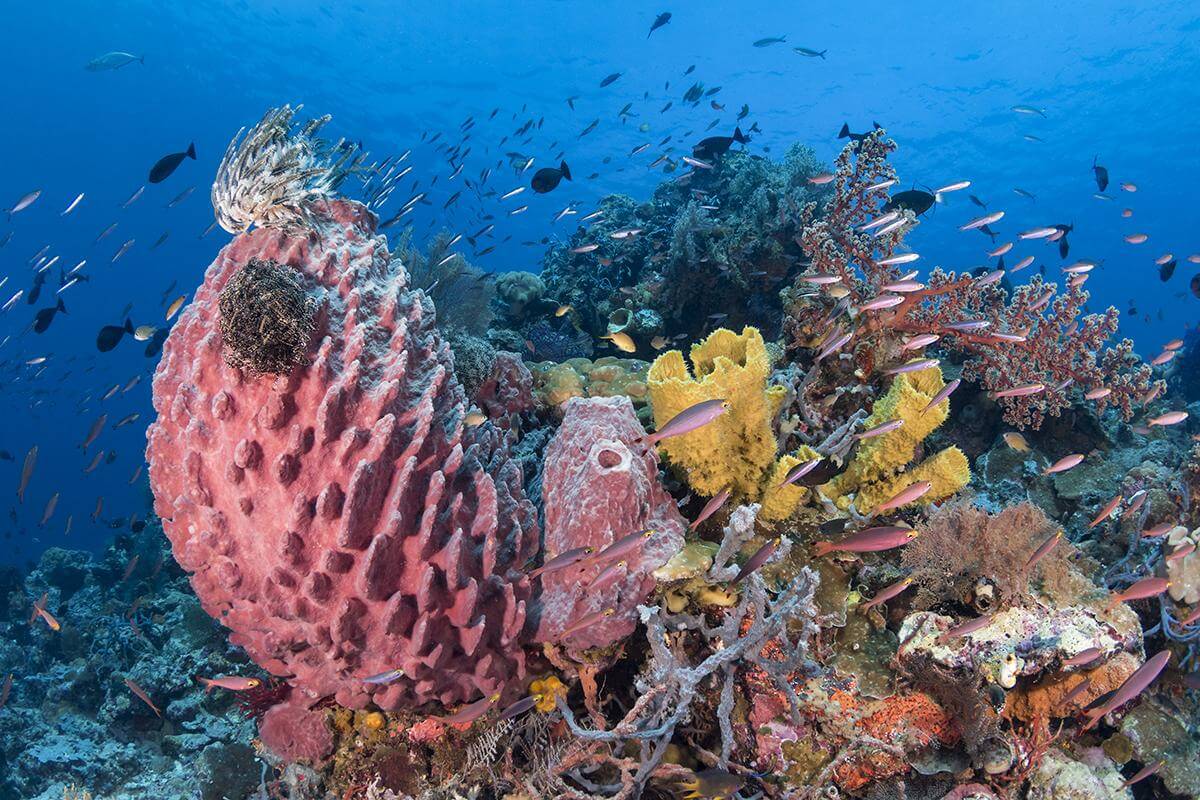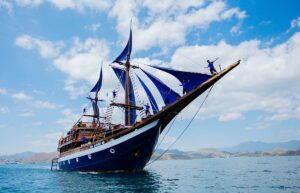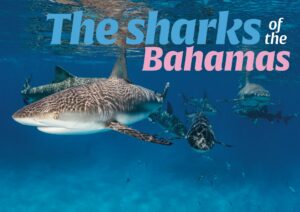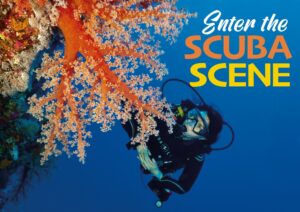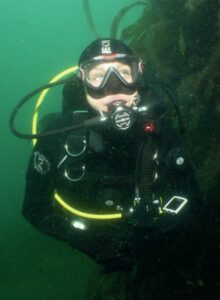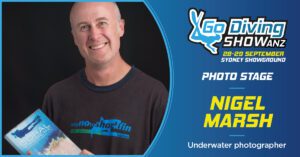I find myself in drydock as we all patiently wait for modern medicine to get enough of a handle on COVID-19 to make travel once again realistic.
Hence, I’m left with a lot of time to reflect where I have been and where I would still like to go.
So, when our Editor-in-Chief, Mark Evans, asked each of us to choose our Top 10 Best Dive Sites in the world, I said “alright, I’m game!” While some might argue that not all of my personal picks are the Best of the Best, they all offer A-class diving.
Join the conversation on one of our social media channels and let us know what your best dive sites in the world would be!
Jupiter Wreck Trek, Jupiter Florida (USA)
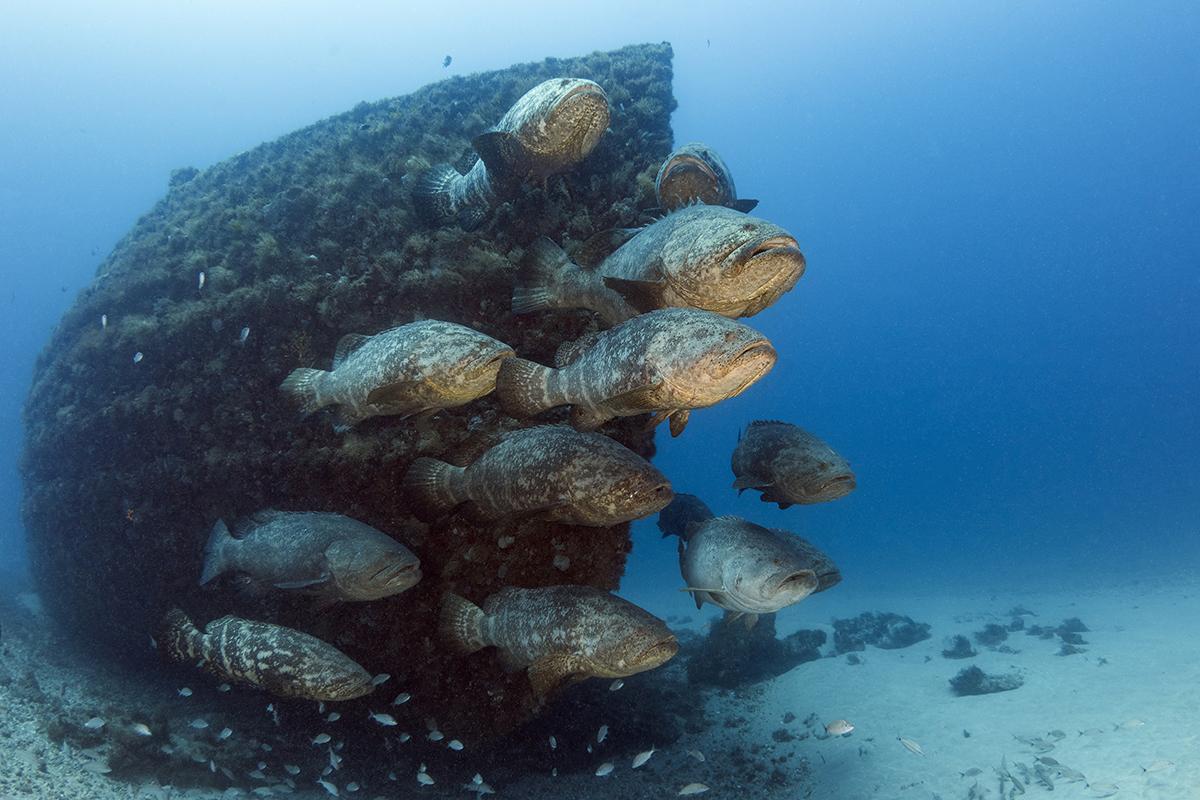
As a South Florida resident with a diving history here that goes back to 1975, you could say “I know a thing or two”, because I’ve seen more than a thing or two. Close to home is the Palm Beaches where the diving presents the opportunity to see a lot of marine life due to the influence of the Gulf Stream.
The close proximity of this oceanic current’s constant flow of water enlivens area reefs, bringing the nutrition needed for corals, sponges, and fish life to thrive. The flowing water serves as an oceanic highway of sorts for a multitude of migratory and open ocean marine life. Just about everything travels along this corridor, from the expected such as large barracuda, sharks, sea turtles, jacks, mackerel and tuna, to the less expected like sailfish and marlin.
If I had to zero it down to just one specific dive site, my personal favorite is a compilation of wrecks in 90 feet of water called the Jupiter Wreck Trek. First is the Zion Train, a 164-foot long freighter, which was scuttled back in June 2003 and since been torn apart by passing hurricanes leaving the stern section as the largest piece of its remains. Next, to the north, is the Miss Jenny, a small barge sitting upside down in the sand.
Coming off the Jenny, divers will cross a 100-foot wide opening to find the last wreck in the lineup, the Esso Bonaire. Interestingly, while the Bonaire, a 146-foot freighter that was sunk in the 1980’s making it the oldest, is also the most intact sitting up right in the sand.
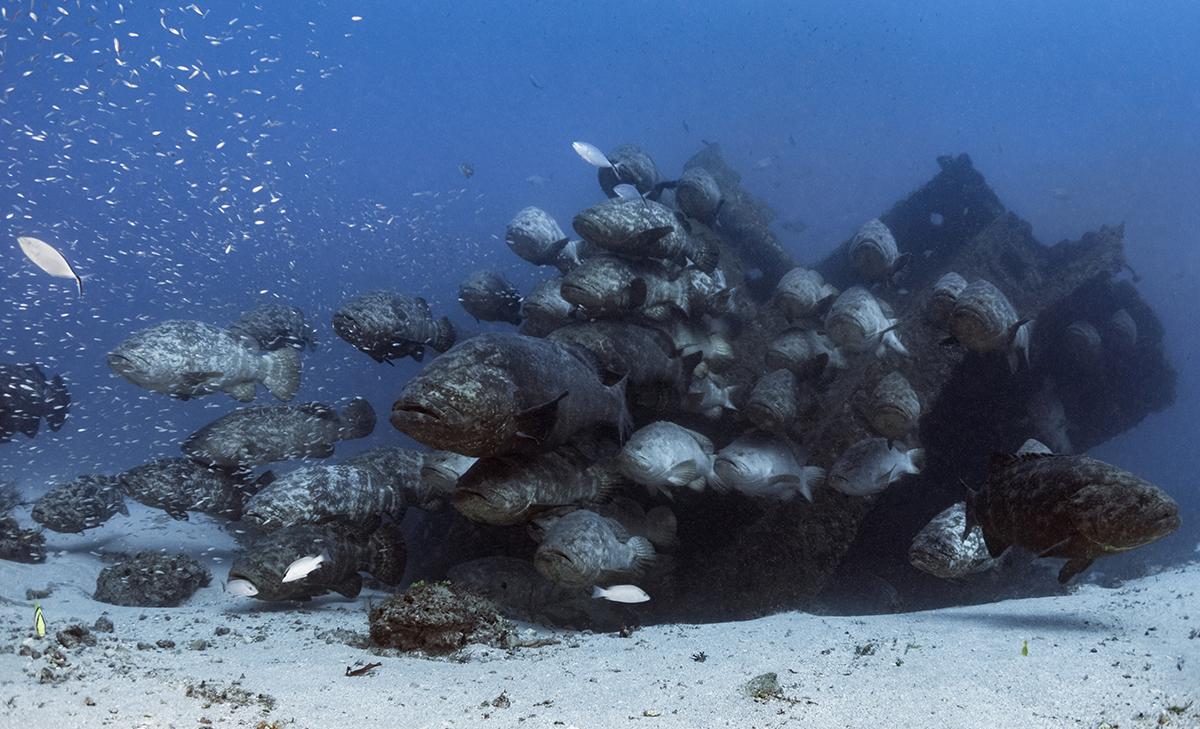
These wrecks are not necessarily what I would call highly photogenic. Their real value does not come from dramatic profiles and places to do serious penetration, but for what collects around them. In addition to drawing in sizable schools of small baitfish, jacks and spadefish there is the larger stuff like greater barracudas, sharks– large lemon sharks being the most prominent.
The best photo opps is the Wreck Trek’s resident population of goliath grouper. Goliath groupers (Epinephelus itajara) are the largest predatory, reef-dwelling boney fish in the Tropical Atlantic and Caribbean weighing as much as 500 pounds/ 226 kilos. Getting up close to one of these mammoth fish is a memory most divers never forget.
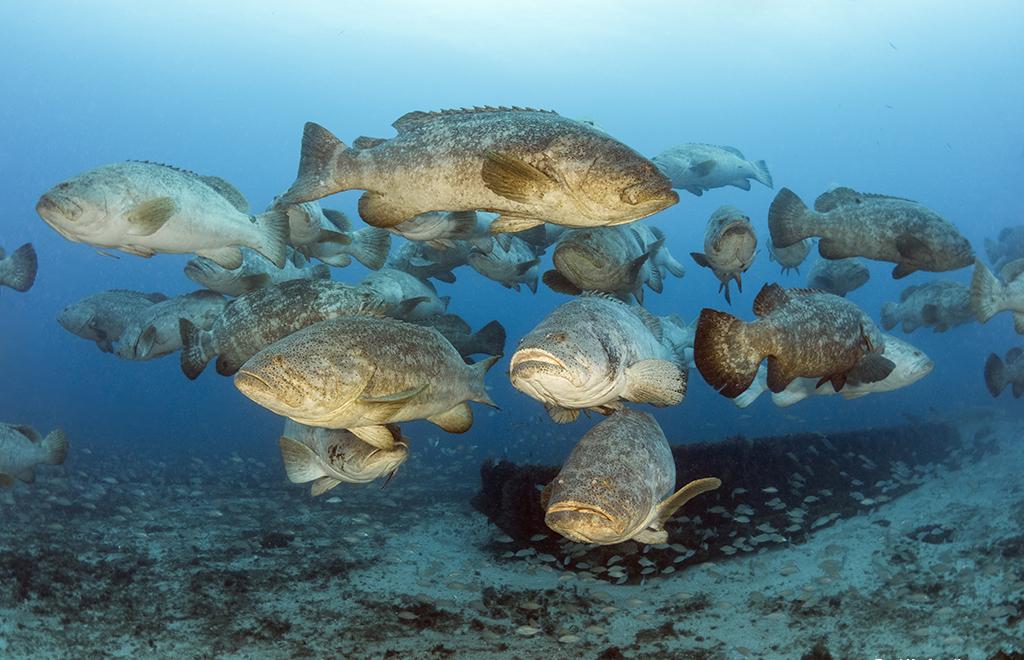
If you should happen to be here during August through September, you are sure to see a spectacle unfold off the coast of Palm Beach County not likely to be seen anywhere else in the world; goliath grouper spawning season. During these late summer months, these giant groupers form aggregations numbering between 40 to 90-plus around a small handful of sites, one of which is the Jupiter Wreck Trek.
Coming from somebody who has done these dives year after year you would think I would have become jaded to seeing them. Not in the least. In fact, I am already chomping at the bit to get back there again, which is why it deserves a spot in my list of top 10 in the world.
Caribsea Wreck, North Carolina (USA)
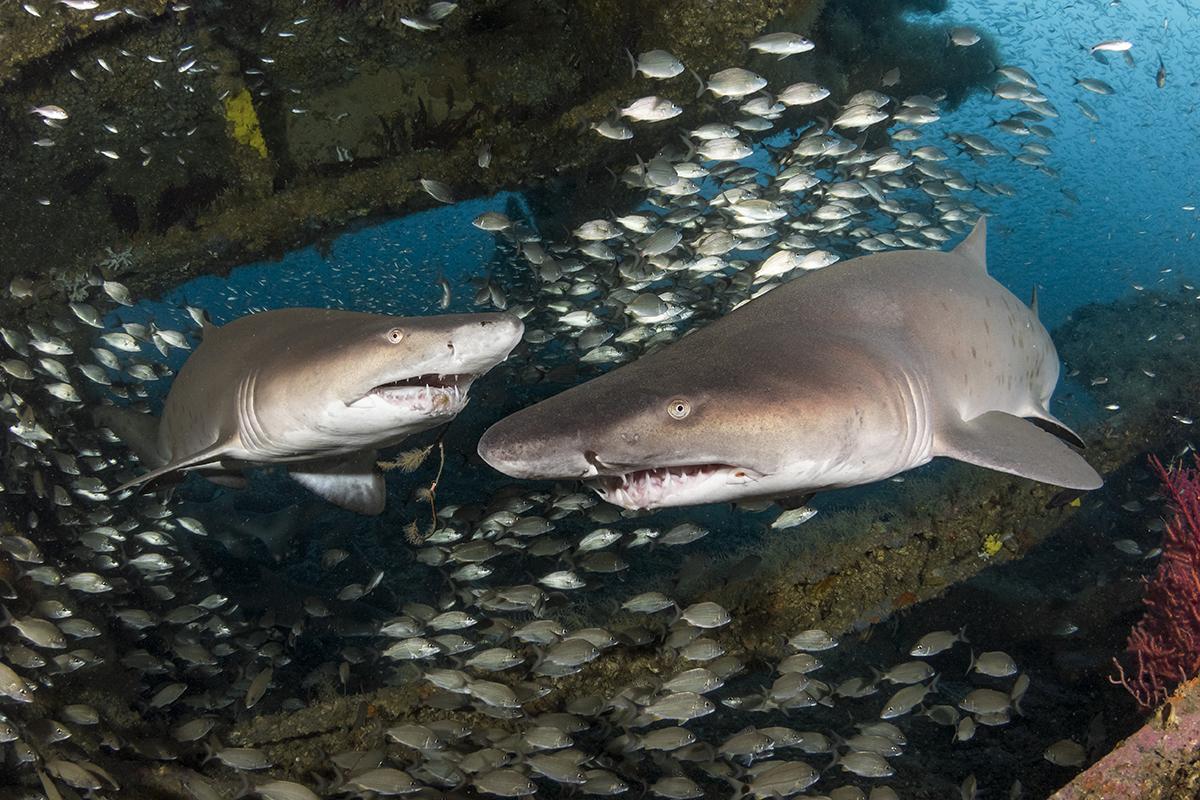
The North Carolina coast offers many underwater rewards, but it does demand a bit more of the diver than what will be found in the typical tropical dive resort experience. From Morehead City, the region’s signature wrecks such as the U-352, Papoose and Schurz lie upwards of 35 nautical miles offshore. The ride out and back averages an hour and half each way, therefore departures are early morning.
The attraction for most is not so much the actual structure of the wrecks themselves (granted the U-352 is pretty cool), but the magnitude of marine life on and around them, namely sand tiger sharks.
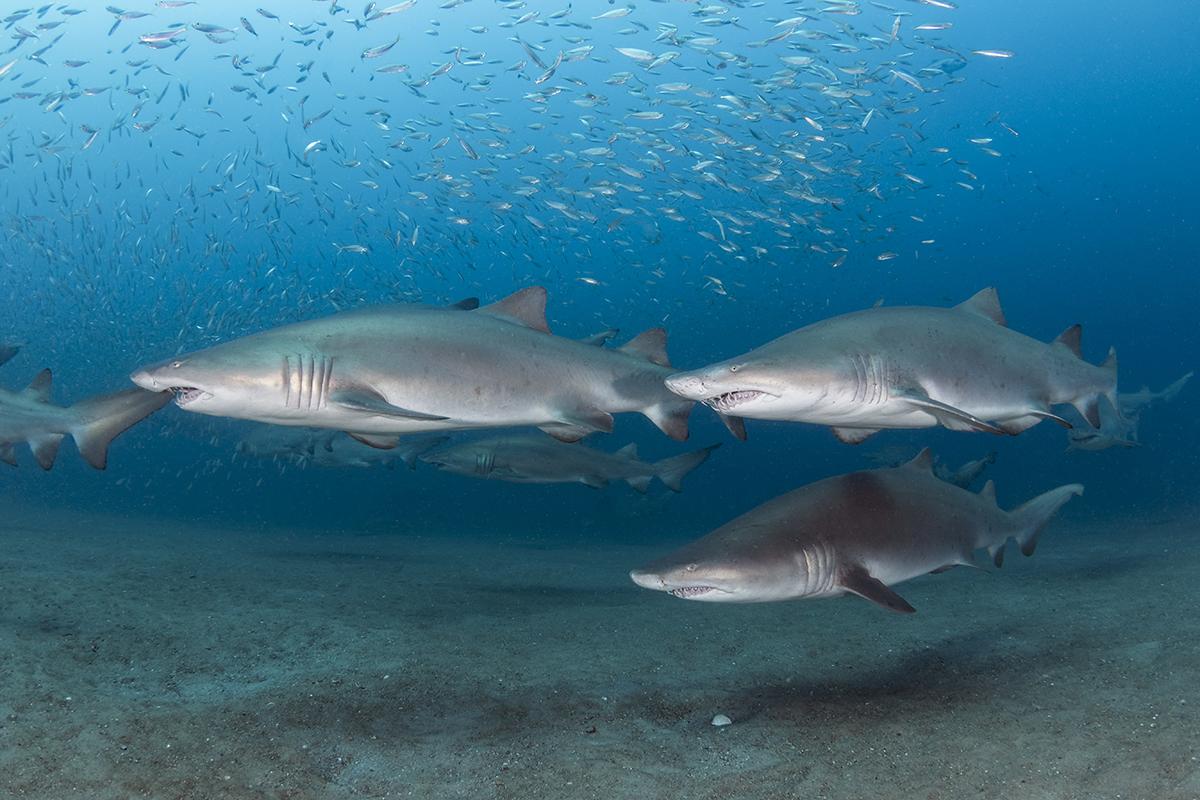
Not to be confused with the tiger shark (Galeocerdo cuvieri), sand tigers (Carcharias Taurus) with their distinctive, nightmarish dental work, actually pose no threat to divers. Even knowing this, divers are apt to feel a tinge of adrenaline the first time they come face-to-face with one of these snaggle-toothed beasties.
Anxieties typically fade after a few minutes with the realization that these sharks are disinterested in divers’ activity. They also come across as being on Valium by their apparent slow movements with jaws held partially agape.
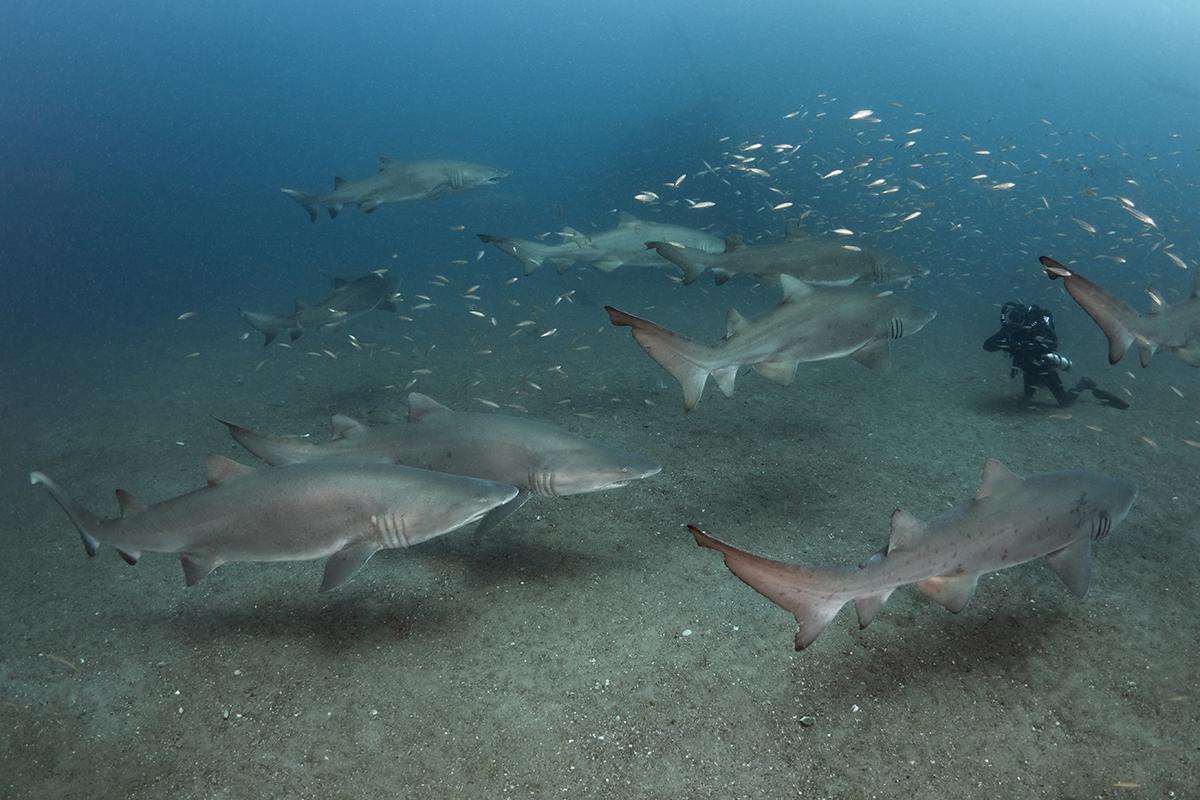
A feature I find entertaining with large-body sharks such as these, which can reach lengths of nine feet, is that they can hover almost motionless in the water column using deliberately slow sweeps of the tail. How can they do that?
Sand tigers, like all other sharks, lack the swim bladders that bony fishes have and use to maintain neutral bouncy to save energy. Instead, they have developed a unique strategy to buoy their dense bodies to a neutral state in the water by going to the surface and gulping air, which they hold in their stomach. Think BCD.
When it comes to having a serious need to see large sand tigers, the wreck of the Caribsea is one not to be missed. The depth of the Caribsea’s broken up wreck lies in 90 feet of water, surrounded by acres of flat sand bottom. As result, the Caribsea is an action point to large schools of bait fish, which in turn attract a large number of jacks, grouper and the star attraction, sand tigers.
While underwater clarity here varies widely between lows of 20 feet all the way up to 70-80 feet, it’s not uncommon to count anywhere from 50 to 90 sand tigers slowing cruising around the wreck. A photo of you or your dive buddy with one of these sharks with their gnarly smile is sure to make your friend’s jaws drop.
Tiger Beach, Little Bahama Banks (Bahamas)
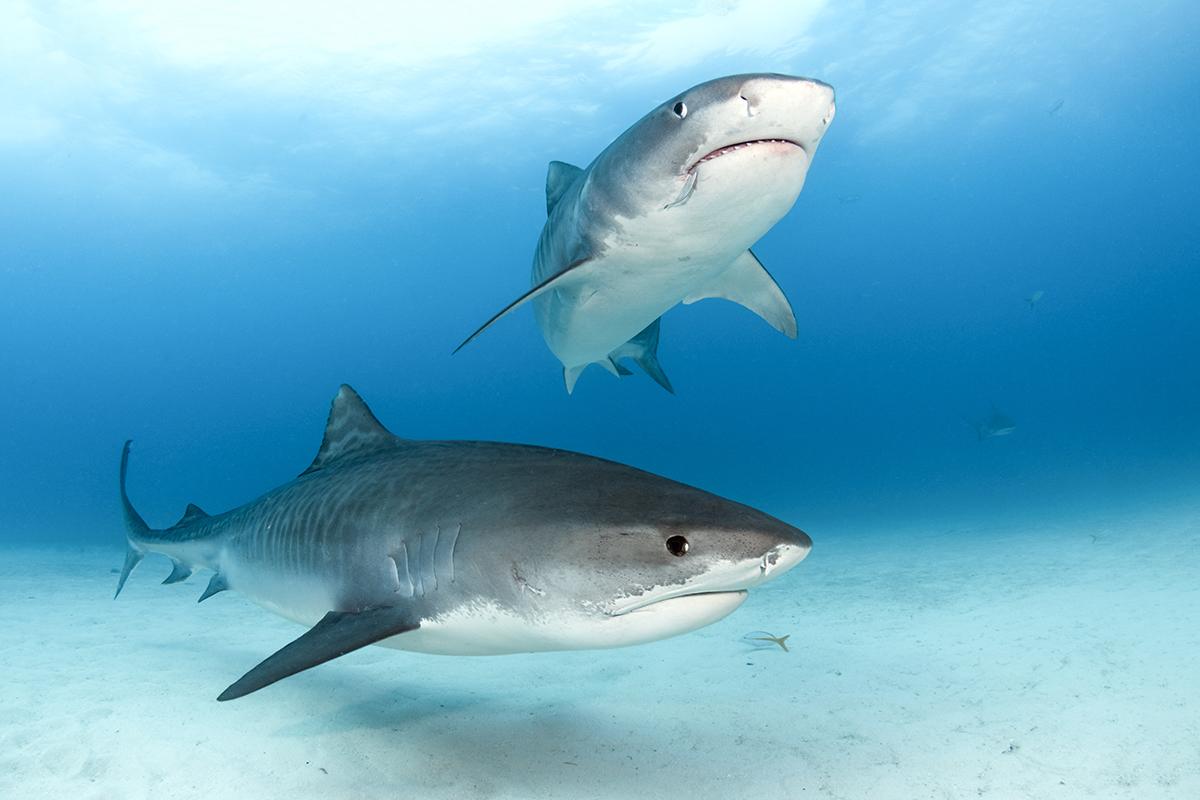
It's hard to find anyone who hasn’t heard of Tiger Beach. While sharks are for the most part a given when comes to diving in the Bahamas, Tiger Beach above all others, takes center stage for being the first destination to consistently deliver (for 18 years running) the opportunity of diving with tiger sharks (Galeocerdo cuvieri).
Located 20 miles / 32 km north of the West End of Grand Bahama Island, Tiger Beach is not a beach, nor is it a single dive site; it’s actually a compilation of spots where liveaboards and perhaps a land-based charter or two work to bring in the sharks.
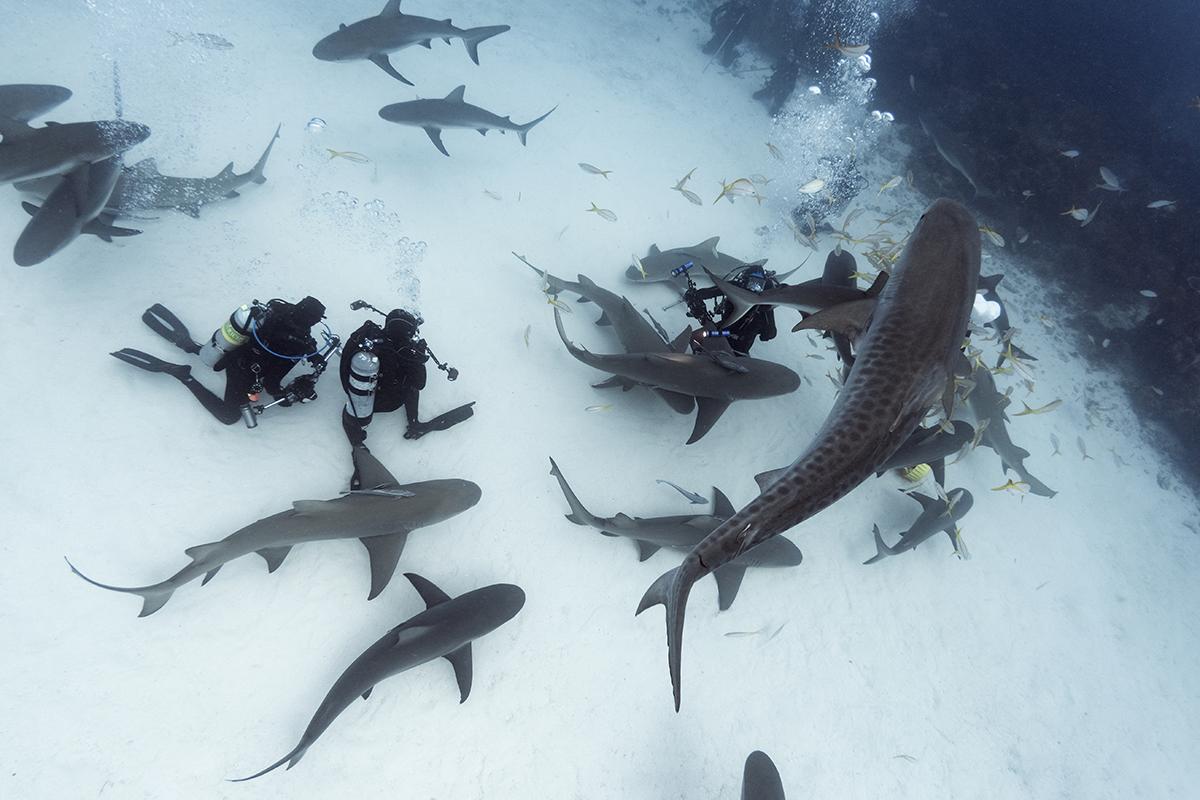
As such the depths for these dives in the area vary from as shallow as 15 feet to as much as 60 feet. Throw in the fantastic tropical conditions the Bahamas are known for–super clear visibility with immaculate sand bottom and two substantial sized patch reefs with vibrant colonies of gorgonians, corals and sponges. Add an equal abundance of fish life into the mix with little current and you have as perfect a set of conditions as one can get for seeing and photographing sharks.
And as many a photographer has learned, in addition to the tigers, which come in two sizes, large and extra-large (9 to 15 feet long), you also get a huge heap of large lemon sharks and Caribbean reef sharks, plus a few nurse sharks and occasional bull shark. Also, never rule out the possibility of a visit by a greater hammerhead, as they are prone to do during the latter winter months and early spring.
As a destination for seeing sharks up close and personal, there is no question why it sits in the top 10. What also needs to be understood is that although these sharks have been around a lot of divers in their life, they should not be treated as something you would find in a petting zoo.
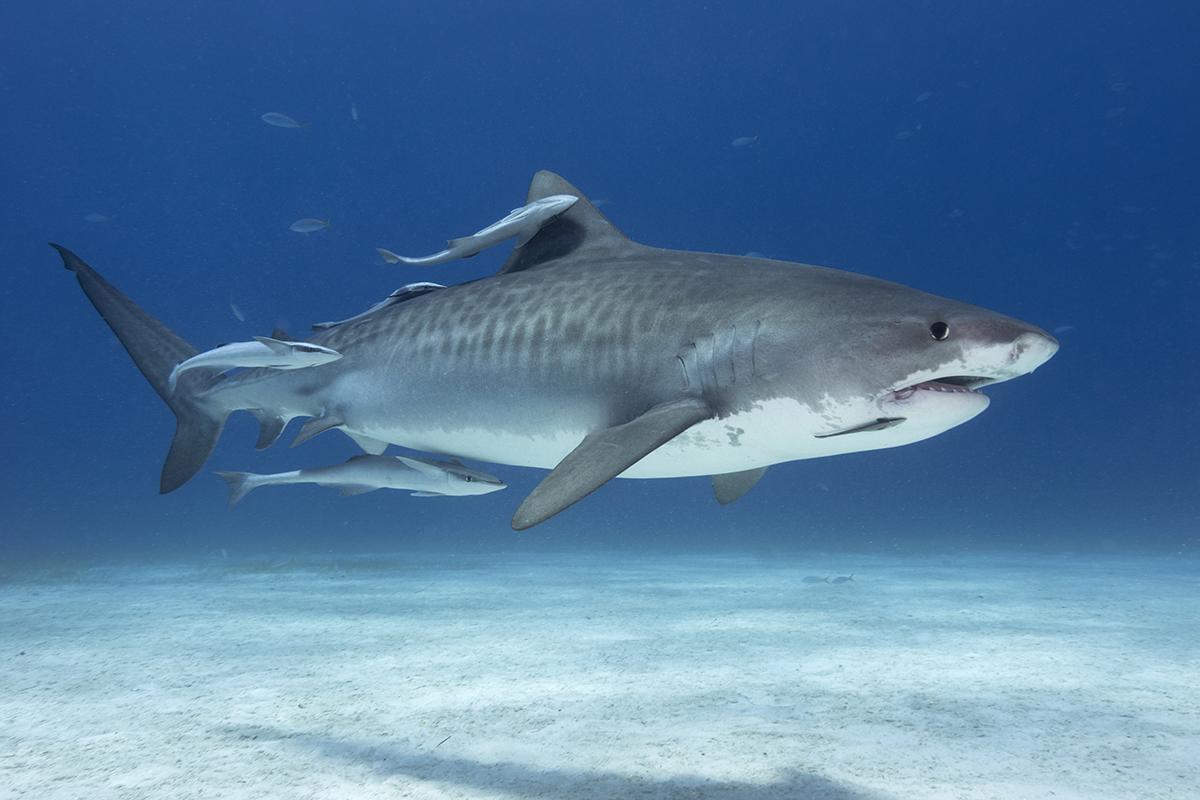
In addition to being quite large their general behavior can also be highly deceiving. For example, two of Tiger Beach’s premier ladies, Emma and Hook, are both over 14 feet, and you’re never sure what they are contemplating. The typical pattern is one of slow deliberate movements as they warily swim about the divers while sorting out where the food is, luring you into a false sense of security.
The foremost thing to remember is that tiger sharks are regarded as one of the top 10 most dangerous sharks in the world. This reputation has largely been earned for their tactic as an ambusher to unsuspecting prey.
Knowing that, not keeping your eyes on that shark as it moves around behind you can turn into a really bad day for you or a nearby diver. The bottom line is to try to keep your head on a swivel, which at Tiger Beach can be more easily said than done when you have 5 to as many as 9 of the big ladies show up at the same time for the afternoon buffet line.
The Boiler, Socorro Islands (Mexico)
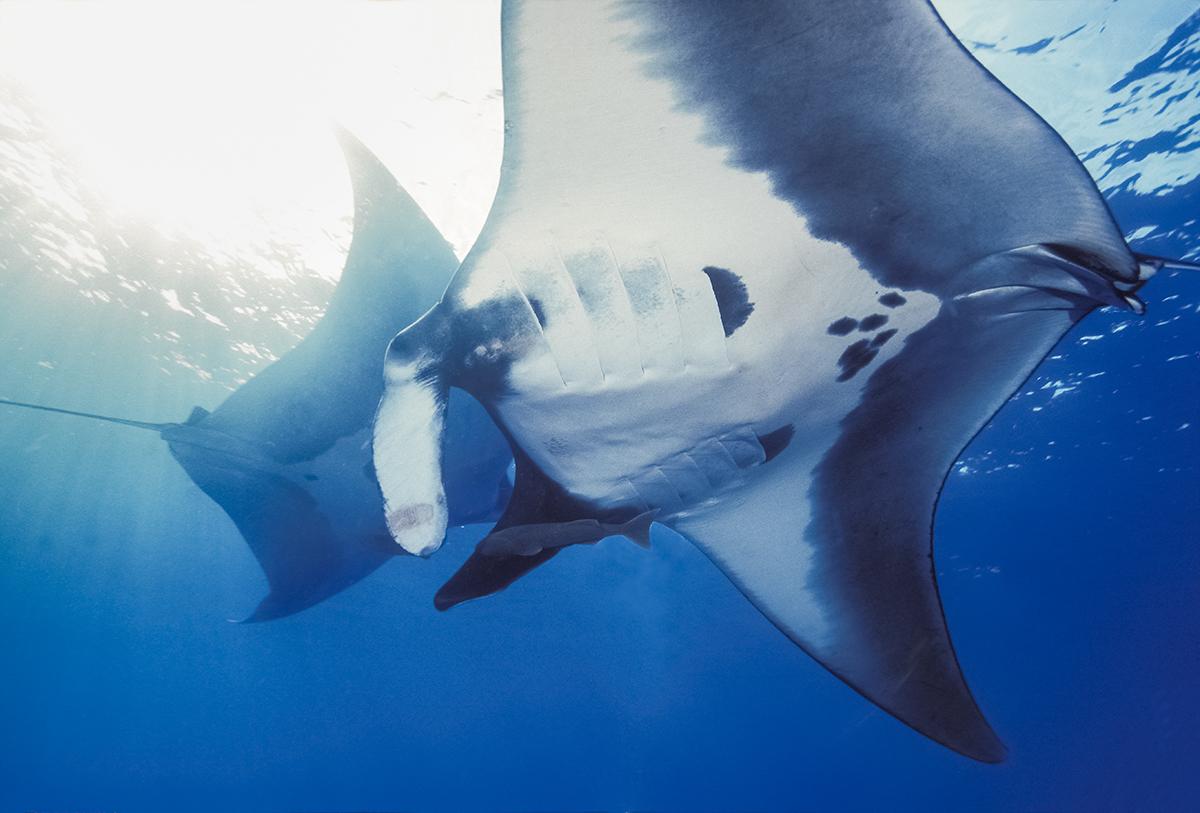
Often referred to as the Socorro Islands, mainly because Isla Revillagigedos is difficult to pronounce, these desolate, volcanic landmasses seldom amount to more than a collection of four tiny ink dots on a regional map. Yet, as a destination for adventure diving in the Eastern Pacific, the Socorro Islands, like their kindred islands Cocos, Malpelo, and Galapagos to the far south, are among this corner of the globe's most impressive for their outstanding tenant of pelagic marine life from schooling hammerheads and silky sharks to colossal sized whale sharks.
What makes the Socorro’s differ from the rest is their signature trait as the ‘place to be’ for diving with giant mantas. The giant manta, or to be more precise the oceanic manta (Mobula birostris) is the largest of all rays obtaining wing spans up to 23 feet / 7 m across with a body weight approaching 3.5 tons / 2.99 metric tons. Although in-water encounters with mantas this big are rare, the rays that converge around the Socorro Islands are by far in no way lightweights averaging 12 to 18 feet across wing tip to wing tip.
Having been to all of the aforementioned Eastern Pacific Islands, I can affirm the region’s reputation is indisputable, with the most standout site for manta encounters on the northwestern side of San Benedicto called The Boiler.
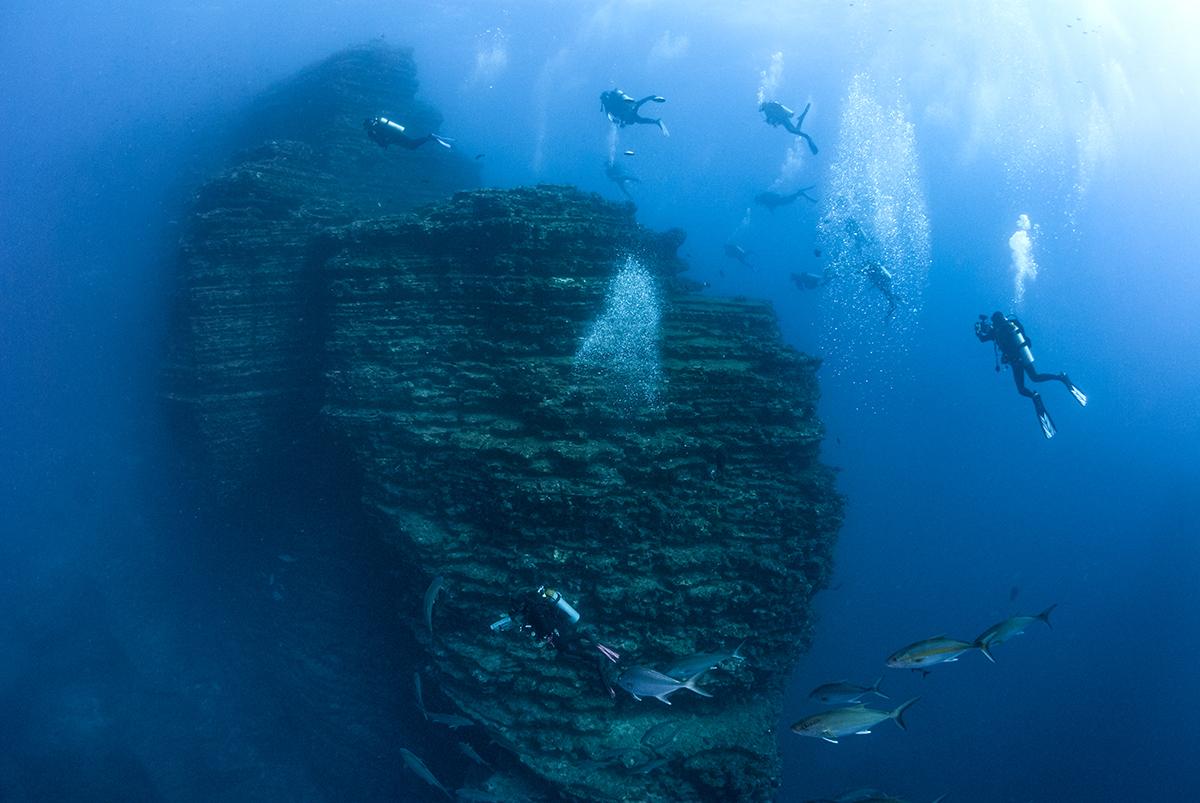
The Boiler is a huge pinnacle towering up from a depth of more than 120 feet and stopping short of the surface, which from the above water vantage point will have the appearance of boiling when a ground swell passes over its top. This is one spot on the site that you really do not want to find yourself.
The feature that sets the giant rays apart from those I have seen in other destinations is that the mantas here typically seek interaction with divers. When they are in the mood, which is often, their first course of action is to glide slowly into a position overhead.
Witnessing these hulking giants of the Pacific in flight with their broad, cephalic fins operating as directional intake scoops for a cavernous gaping mouth designed for feeding on plankton is a mesmerizing sight. Having one, two, three or more of the giant delta winged creatures change direction and glide with the fluidic grace only a creature in full control of its environment could assert just an arm’s length away ratchets things up quite a bit to awe inspiring.
Their primary purpose is to bathe for several seconds in the bubbles released by your regulator’s exhaust. Wow! Bit of shocker to think the noise and bubbles from your reg is for once an attractant rather than a repellent to marine life. And if you’re armed with a camera, you can’t say you didn’t have the opportunity for a shot.
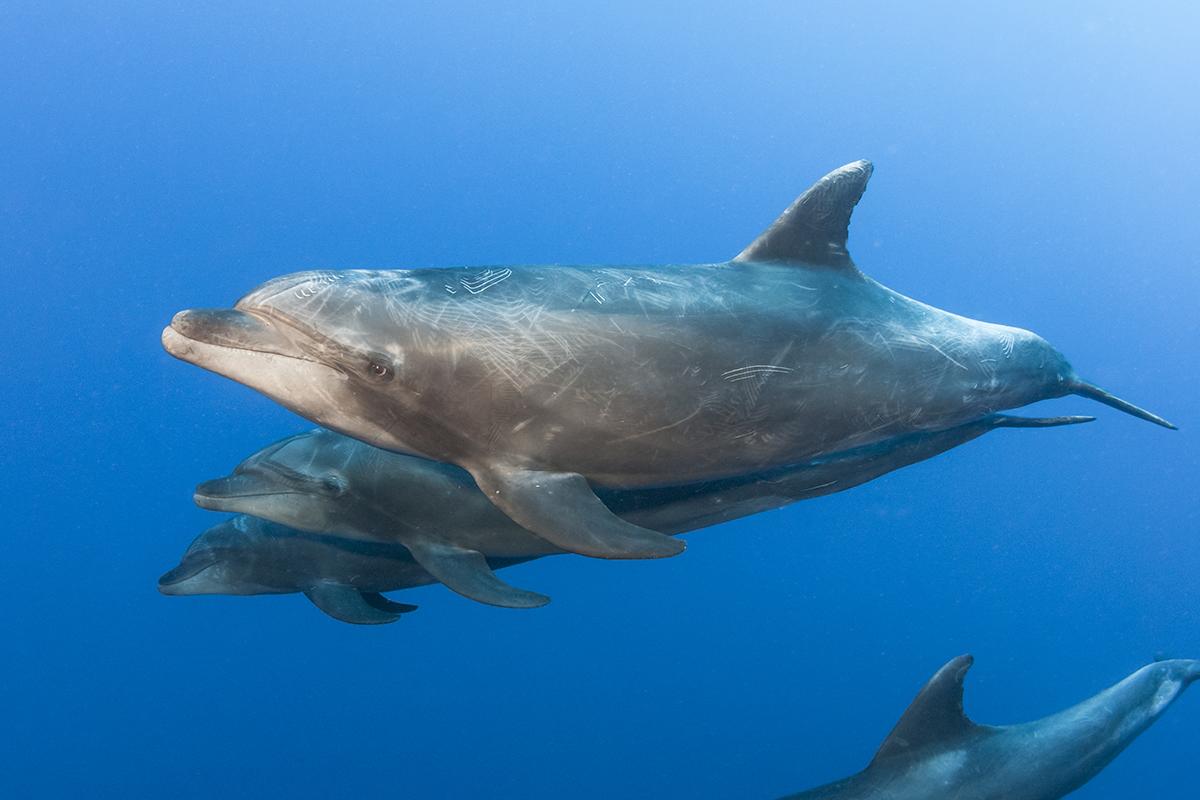
Another feature to The Boiler, if you have not already heard, is the site is also a regular hangout for a gregarious pod of bottlenose dolphins, who like the mantas have absolutely no problem in doing close up meets and greets.
Roca Partida, Socorro Islands (Mexico)
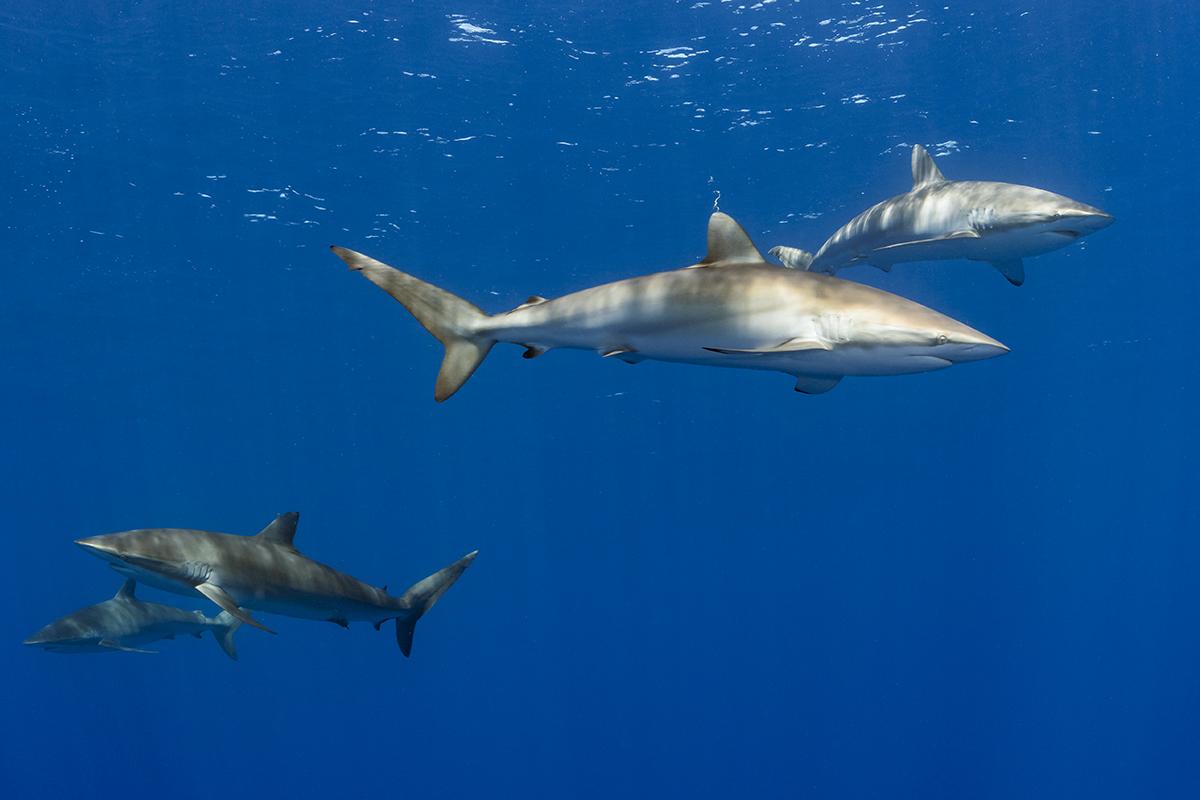
While I’ve made my point about The Boiler, I am not yet finished with the Socorro Islands. There is one more site here for my list, Roca Partida.
Laying 60 miles due west of San Benedicto, Roca Partida (meaning part of a rock), could best be described as a lonely sentinel in the middle of nowhere. And alone it is as the only other landmass close by being Isla Clarion off another 160 miles west/southwest.
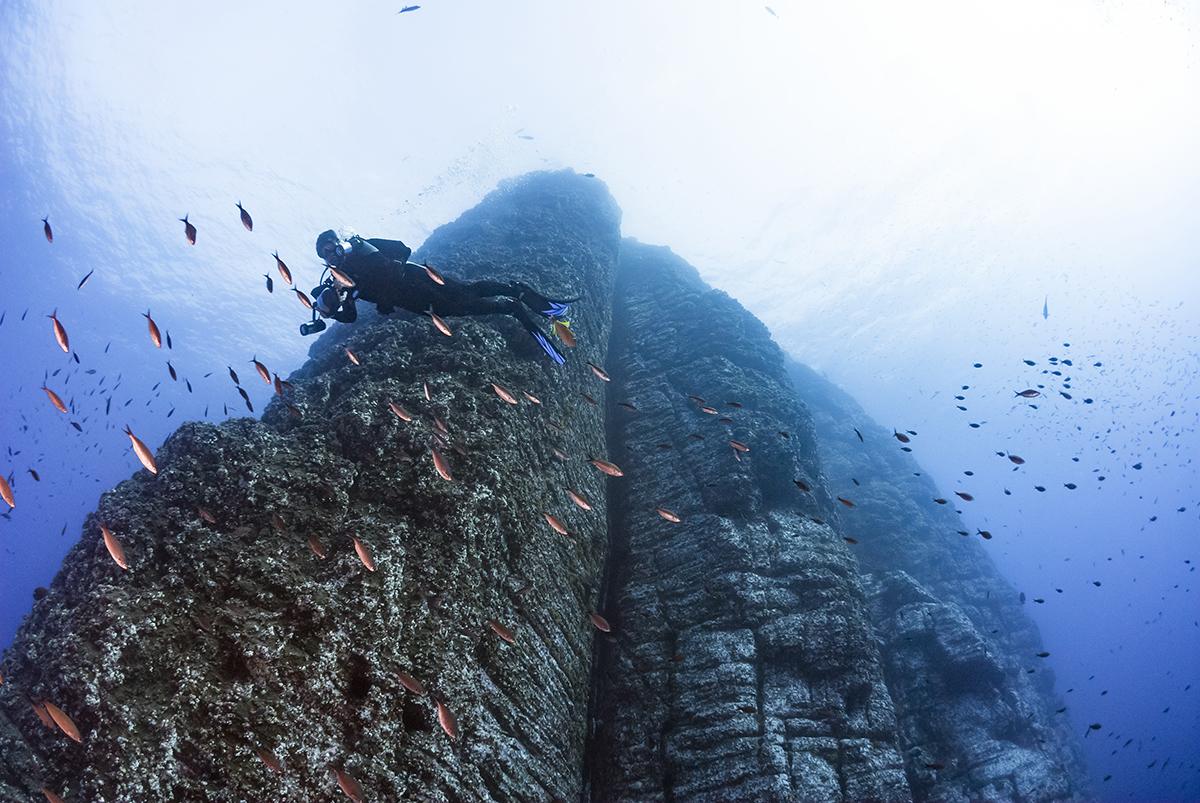
Now for the cool factor. Topographically, Roca Partida is a subsea mountain rising up from the depths in 3,000 feet of water. The feature that makes Roca Partida special is that the seamount’s upper most summit is comprised of a single column of rock that begins down around a depth 200 feet from which it that takes on a complete vertical trajectory before stopping some 60 – 70 feet above the waves. On days when there is little to no current, I found I had no problem circumnavigating the circumference of this rock on a single dive.
So, what makes it particularly hot, as well as worthy of the top 10 list? Like most marine sea mounts, Roca Partida is a magnet for large schools of jacks, big yellowfin tuna, wahoo and of course sharks. To this day, it is the only dive site where I have had the pleasure of seeing more than seven species of sharks–schooling scalloped hammerheads, silky, silvertip, dusky, Galapagos, reef white-tips and a tiger, all on one dive.
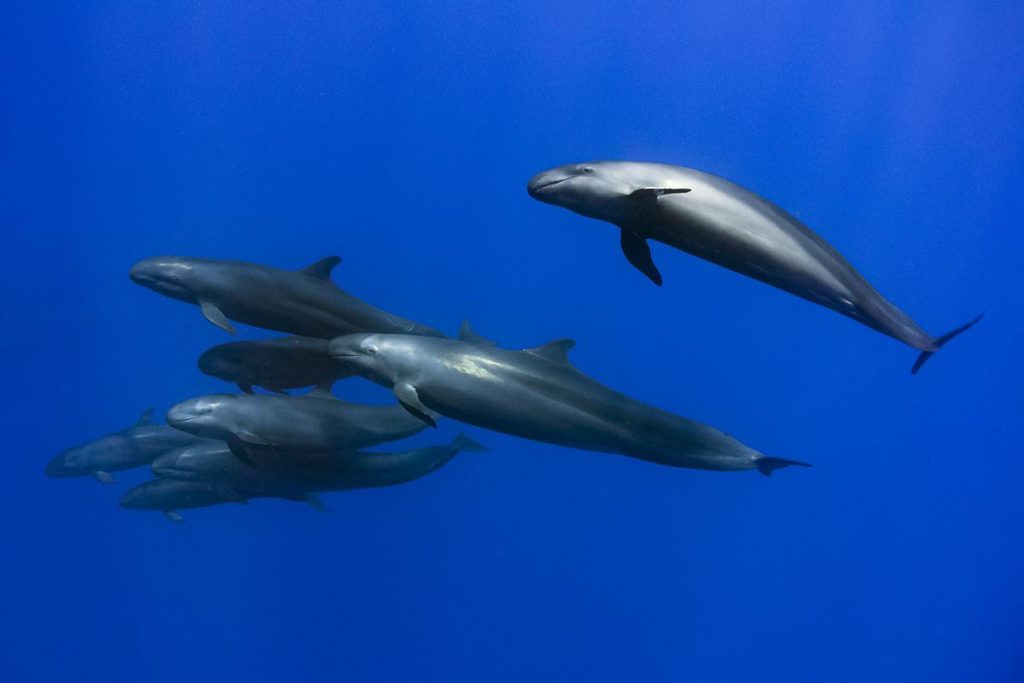
From early January to the end of April, Humpback whales make their annual pilgrimage from the Northern Pacific to Socorro Island to mate and give birth. The in-water encounters with these graceful leviathans are a real treat. For me, it was a mother and calf at Roca Partida. On another trip, we had a surprise visit from a passing pod of false killer whales.
A point of fact; big, ocean going animals are not tied to, nor dependent on any one given location. A good train of thought to employ when visiting the Isla Revillagigedos, try to be flexible in your expectations, and be ready for surprises, as you never know what might show up next.
Darwin’s Arch, Darwin Island (Galapagos)
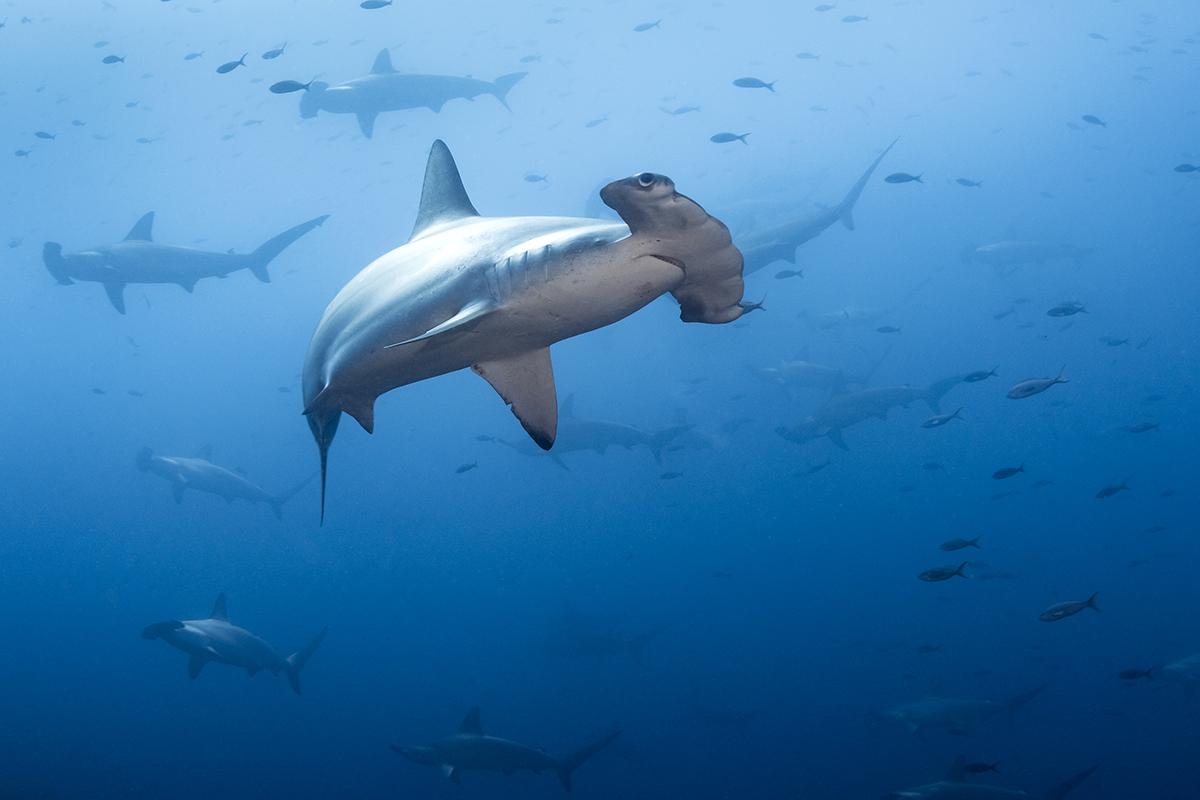
I'm not typically a fan of using words such as “astonishing” or “phenomenal”, or “best” when describing anything. But there are certain destinations and experiences that do on occasion deserve such a superlative. And this is certainly the case for the Galapagos.
The Galapagos Islands, Darwin's Islands, based on his “theory of evolution”, which shook the world, presents one of the most incredible marine biospheres on the planet. Positioned directly on the Equator, 600 miles off the coast of Ecuador, species more indigenous to cooler regions like sea lions and penguins live in harmony with iguanas, tortoises and tropical sea birds.
The diversity of large marine life in the archipelago’s central islands is amazing. But the true piéce de résistance lay a little further to the north, at Wolf and Darwin. Among this region’s gallery of big-ticket showoffs, scalloped hammerheads (Sphyma lewini) assemble in dense formations or schools that often number well into the hundreds. With nomadic schools of tuna passing through come large numbers of silky and Galapagos sharks. During the cloud-covered months of late June through October, whale shark season swings into full bloom around these two tiny islands.
If I had to single out which is the biggest jewel on this crown, for me it is the Arch at Darwin Island. Below the surface, the underwater terrain is a steep rocky slope strewn with large boulders. Parking yourself among the larger rocks provide key vantage points for observing a parade of marine life from huge schools of big eye jacks and scissor tails, to sea turtles, schooling hammerhead sharks, Galapagos sharks, passing pods of bottlenose dolphins, big yellowfin tuna, mobula, manta and eagle rays, as well as the big show stopper, whale sharks.
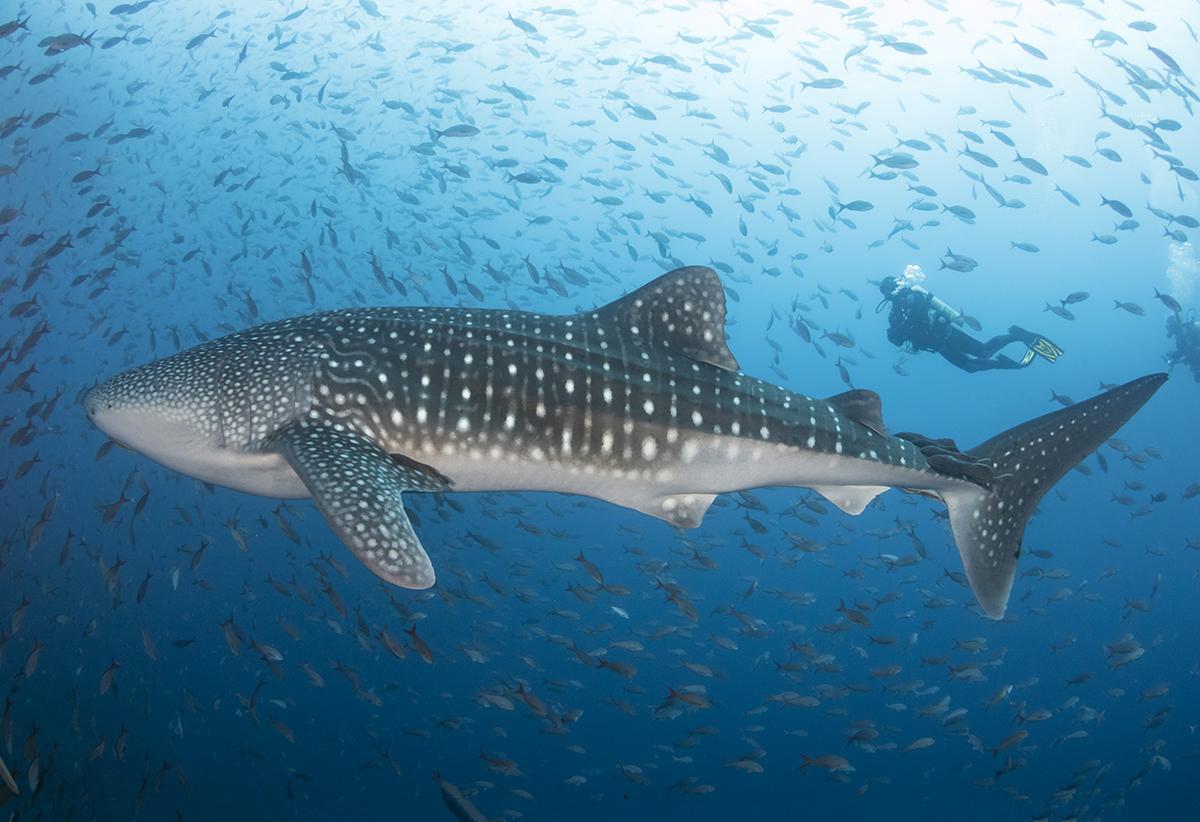
From late May to November, with almost unwavering consistency this single point of the island serves as a converging point for some of the ocean’s largest specimens, whale sharks. For anyone daring to spend time out in the blue, encounters with these colossal, 35 to 45-foot-long filter-feeders can often turn more routine than by chance. Nor is it uncommon to encounter up to 8 different individuals in a single dive.
In addition to seeing whale sharks while hanging out in the blue, be prepared for silky sharks, which like scalloped hammerheads will form up on occasion in large groups.
One thing most divers with experience in this part of the Galapagos Islands will agree on is to expect the unexpected–from a fleeting glimpse of roving black or blue marlin, to pods of killer whales on their way to parts unknown.
Blade, Wakatobi (Indonesia)
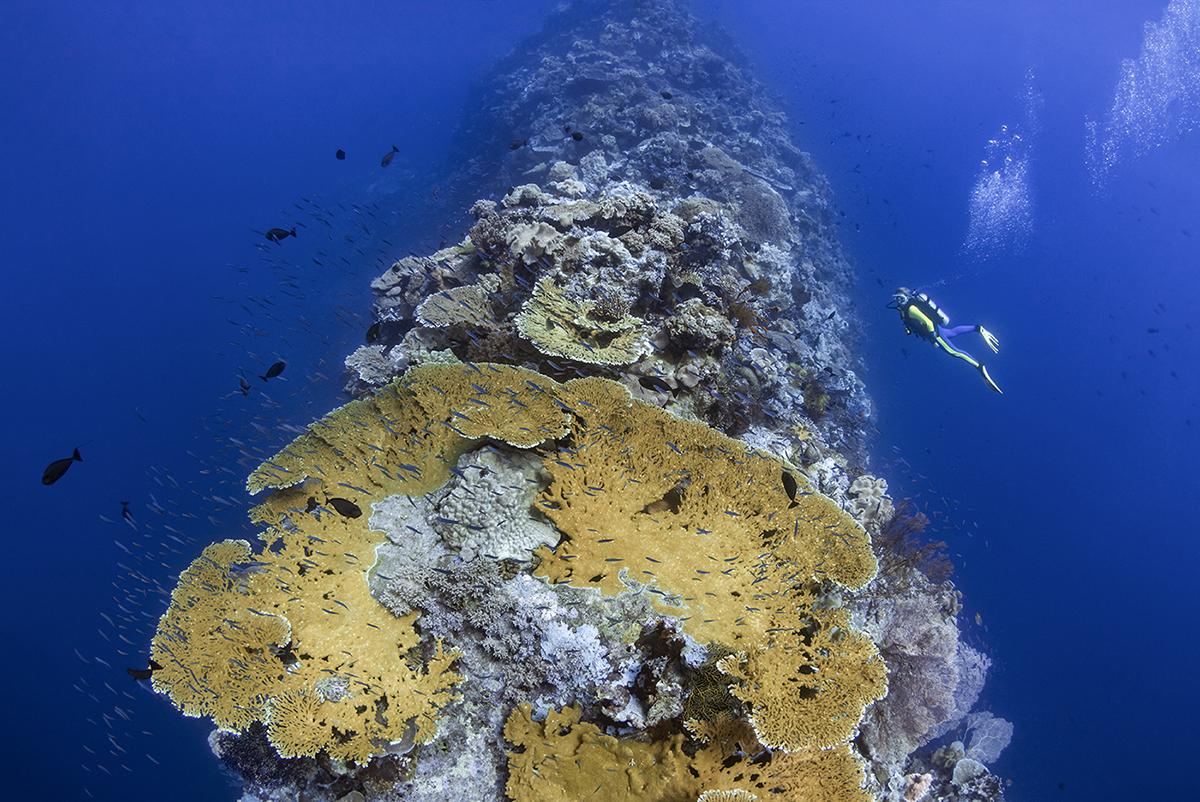
Trading the adrenalin rush to something more in the direction of the divine conjures up a whole different set of destinations and dive sites. Usually, the sites that intrigue me the most are those where unusual or dramatic underwater topographical seascapes fit completely into their own classification. One such example in Indonesia’s Wakatobi Regency is Blade.
To call it a submerged pinnacle would be a stretch as it doesn’t fit the norm. Instead, the formation runs almost in a straight line for more than 200 meters. Even more tantalizing when viewed from an overhead vantage point will reveal just how insanely narrow the formation is; it spans between 20 – 25 feet across plummeting vertically on both sides into the depths.
Dropping down on either side of this formation reveals a profile that evokes thoughts of a walled medieval fortress complete with broadly spaced battlements where parts of the formation’s take a steep turn upwards to within 15 feet of the surface. Others might argue the entire formation resembles a knife with a serrated blade that has been set on edge.
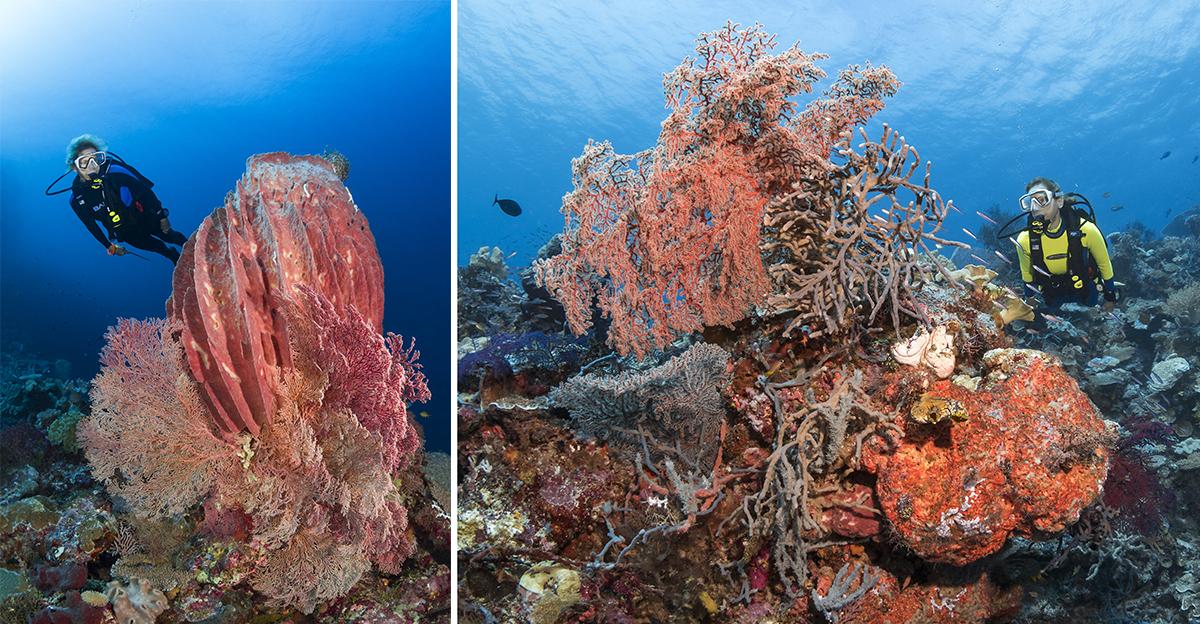
Augmenting the majestic beauty of Blade’s terse profile is a comprehensive collection of corals and sponge indicative to region of the Indo-Pacific. All across parts of Blade’s spine a mix of soft corals, sea fans, and sponges in a multitude of hues aggressively compete for space. In other sections, hard corals like tabletop and turbinaria lettuce coral are more dominant.
Currents are generally mild during most dives allowing divers to take a more leisurely drift from peak to peak. Dropping a little deeper on either side of Blade’s abrupt profile colonies of red whip corals to a variety of sponges growing in thick clusters hang from the walls serving as housing for an assortment of fish and invertebrates including one my favorites, the longnose hawkfish.
Should you find yourself at Wakatobi Resort, be sure to put in a request for Blade. The site sits further afield than most of the others and takes about 45-minutes to reach.
Fujikawa Maru, Truk (Micronesia)

Truk (or Chuuk) Lagoon represents the tropical Pacific’s pinnacle of wreck diving. Here, in clear and calm tropical waters lie more than 60 Japanese shipwrecks dating from WW II. For the Lust for Rust crowd, Truk offers loads of freighters, tankers, a few medium class war ships including a sub, as well as the wrecks belonging to both Japanese and U.S. warplanes.
Considering that I have only visited once, I am still surprised by how much I remember about one wreck in particular, the Fujikawa Maru. Built in 1938 for the Toyo Kaiun Kisen Kaisha shipping company in Japan, this 437-foot cargo freighter was requisitioned by the Imperial Japanese Navy at the onset of World War II to serve as an armed aircraft transport. While it laid at anchor inside Truk Lagoon, it was caught by surprise and sunk in 1944 by a bold US naval air strike called Operation Hailstone.
Landing upright in 112 feet of water, the huge freighter presents a stately profile stopping 15 feet short of the surface. Like the majority of wrecks lying in depths less than 120 feet, the sea has shown its remarkable ability to waste nothing.
Left exposed to the currents and penetrating rays of the sun, the ship’s steel skeleton has been turned into a foundation for a plenitude of corals and sponges, not to mention hamburger-sized razor clams. In several instances, growth has taken hold with such vengeance that recognition of a ship’s more obvious deck components such as the cargo wench sometimes seem incomprehensible. Others like the Fujikawa’s large bow and aft gun placements – intended for defense, are more discernable, standing erect under a blanket of soft corals, fans and sea anemones.

Backlit by the sun, Fujikawa’s massive set of King posts and masts resemble tall trees through their own endowments of multi-hued corals. Places governed more by the shadows, cargo holds, pilot houses and engine rooms are more reminiscent of men having been here. While the disheveled fuselages of Zero fighter planes draws the attention of some, the engine room’s curious looking air compressor, named R2-D2, was a personal favorite. All aided by the fact that a large part of wreck, from its pilothouse and main superstructure down to its galley and engine room are easily accessible.
To summarize it best, the Fujikawa Maru still lives up to its reputation as one of Truk's must dives.
Palancar Reef, Cozumel (Mexico)
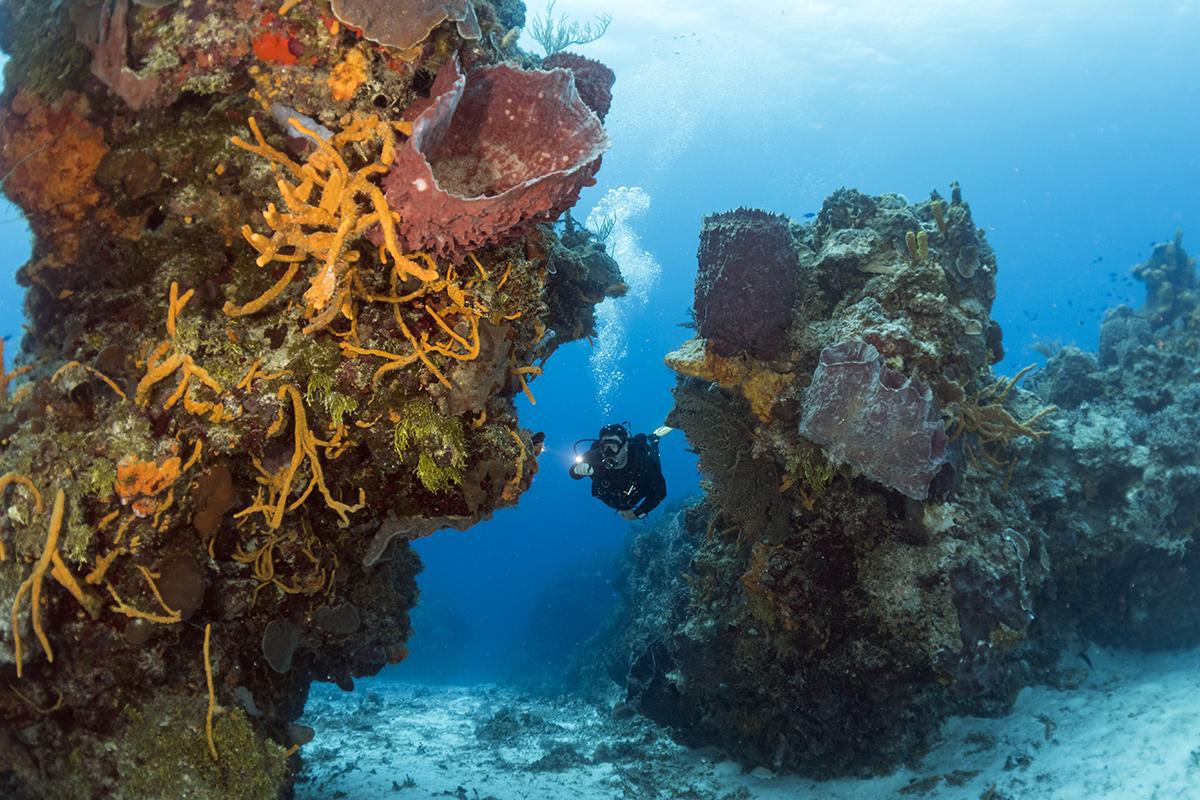
Last but not least, I bring you to one of the Caribbean’s first marketed dive destinations in Mexico’s Yucatan region, Isla Cozumel. In most traveling divers’ eyes, few places in the Caribbean match up to the likes of Cozumel. The waters here are home to some of the healthiest and most colorful reefs in the Caribbean.
A steady northerly flow of oceanic water washes over the reefs to promote life and growth, while also delivering the excellent water clarity divers crave. Healthy reefs mean healthy marine life, and Cozumel is home to 260-plus species of fish, more than 100 types of coral, and a wealth of colorful sponge life. And it’s all found at Palancar Reef.
An attractive feature to the way things are done, dive operators here practice what is known as a “live boat drift” during which divers are dropped in on part of the reef and picked up at another, removing the need to remember where the down line for the mooring is located. Taking that burden off your shoulders can make drift diving one of the easiest and most enjoyable types of diving you will ever experience.
Underwater navigation is equally easy, as all routes lead northward with the currents. By going with the flow, divers may find they use less air and can enjoy longer and more relaxing bottom times. When it's time to resurface, there's no need to search for the boat, it will be right there waiting for you.
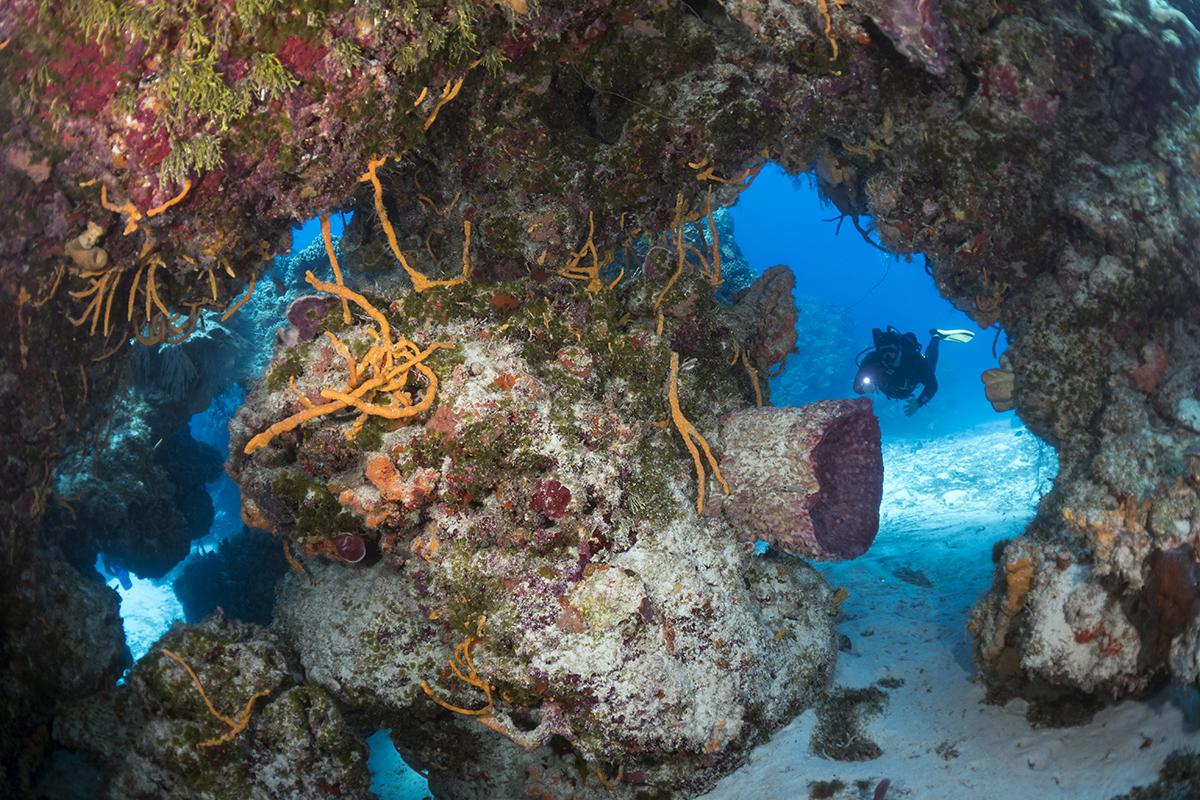
Drawing my focus down further towards the island’s more southern region sites like Palancar Caves and Palancar Bricks top the list of where I would like to spend more time. Here, coral ramparts perch on the edge of deep water and have grown massively large upwards and outwards.
Shaped by the Yucatan current’s ceaseless flow, their convoluted structures mesh together in numerous places creating a maze-like network of canyons, swim throughs, and arches that one can almost get lost negotiating various routes available. From an underwater photographer’s perspective, the combination of dramatic contours shaped by eons of coral growth augmented by forest upon forest of sponge colonies with their rich yellow and orange hues is something to be admired.
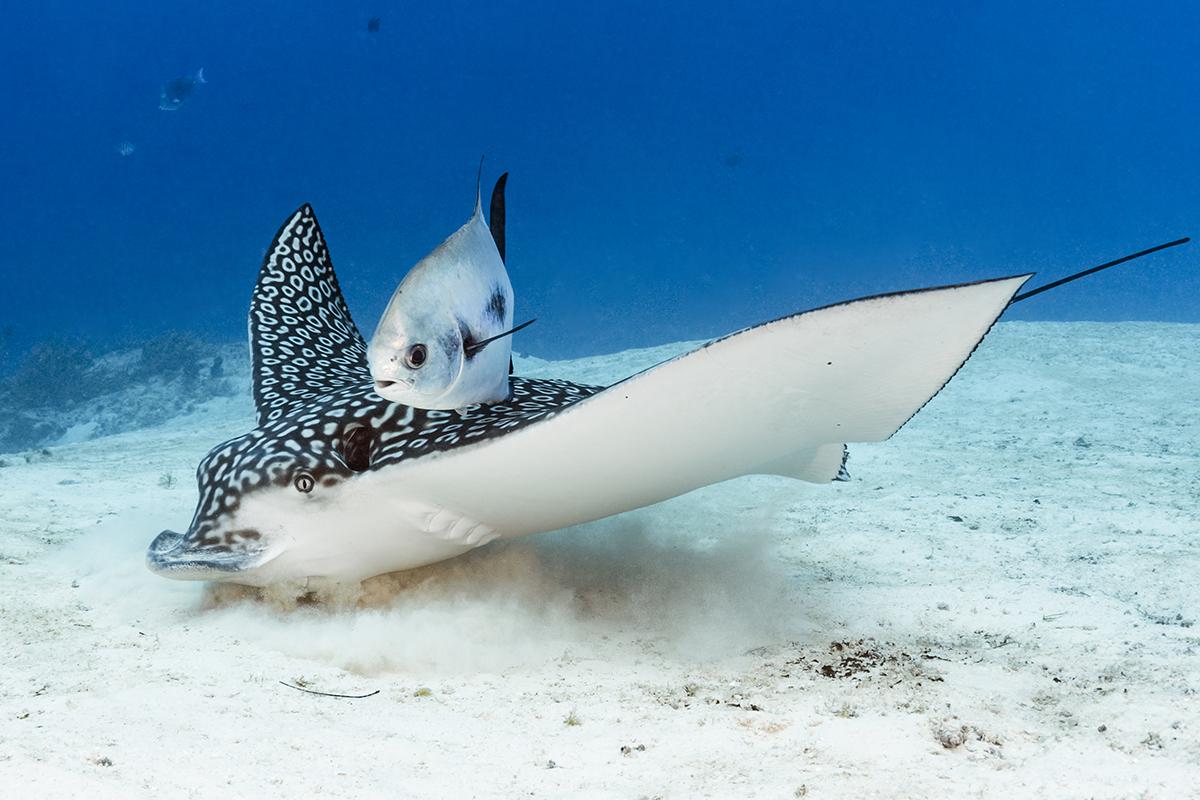
Equally rewarding is spending time skirting the edge of the reef track facing the sand flats. This is often reserved for the second half of the dive as this region will often provide opportunities to watch eagle rays foraging in the sand for food while at the same are shadowed by a young jack or pompano waiting for a crab or shrimp the ray might flush from the sand.
Is this a place I would return to? A most definite yes!
Salt Pier, Bonaire
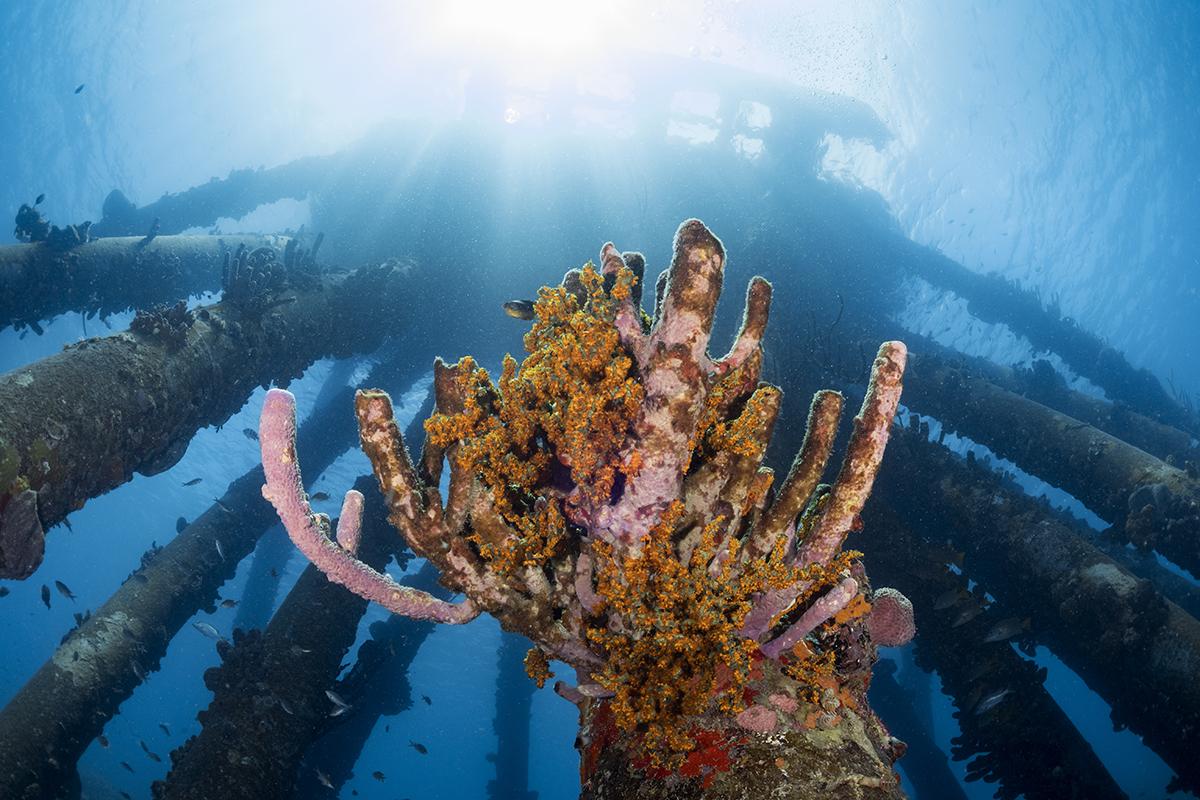
Our Editor-in-Chief, Mark Evans, holds a preference for the Hilma Hooker in Bonaire, but my favorite is the Salt Pier. This is namely because there is no other dive site I can compare it to in the rest of the Caribbean or Bahamas. Salt Pier is big, and beautiful, and you can dive it from shore or by boat.
Located a few miles south of town on the coastal road, the pier rises out of a flat landscape of salt pans. Designed to carry evaporated sea salt from the Cargill Salt Works to awaiting freighters off the rocky beach head, the pier stretches some 600 feet across the road and out into the sea.
The only time the pier is off limits are days when the freighter is scheduled to take on a new load of salt. Once the task is complete and the ship is gone, the pool is back open.
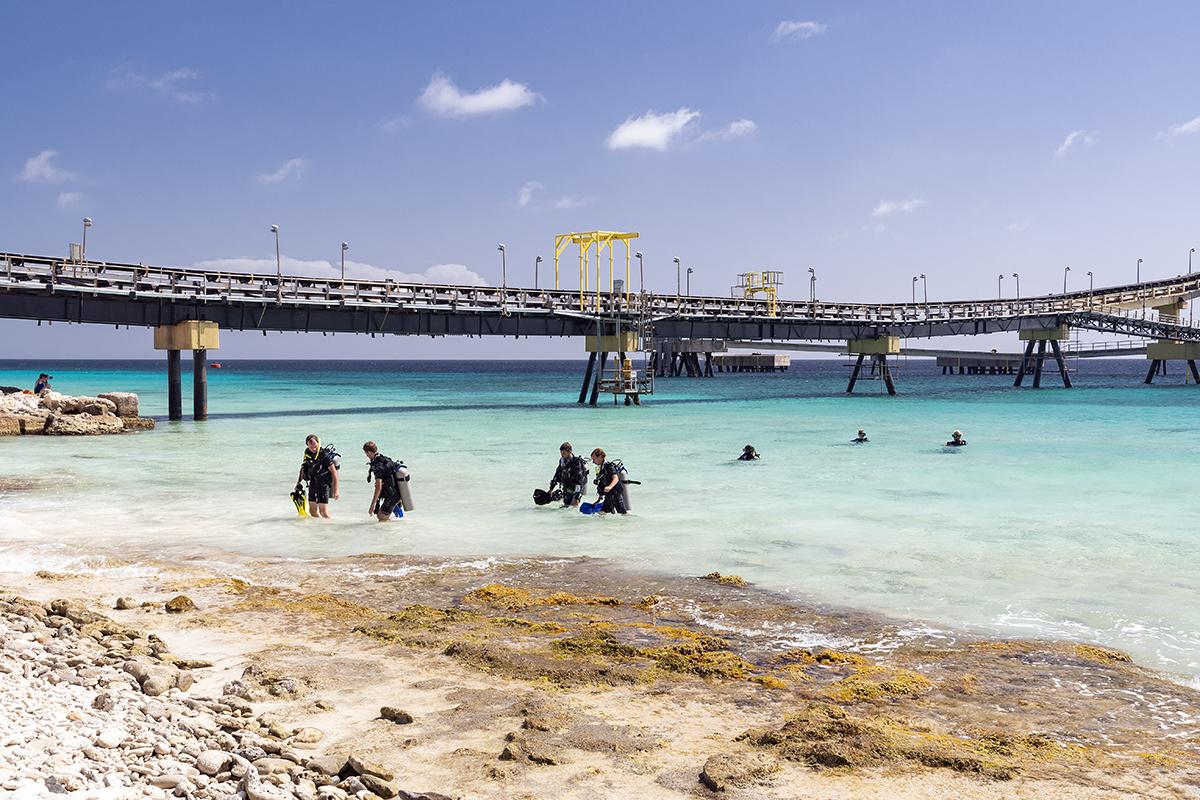
At its western terminus, the pier’s massive concourse of concrete and steel pilings form a giant T-shape to the north and south, with the pilings dropping to a depth of 50 feet along the edge of the reef slope. Seen from underwater, the pier’s network of 3-foot diameter columns resemble a forest of pine trees vaulting skyward.
It is for this that Bonaire’s Salt Pier remains one of my favorite dives on the island, particularly during morning and late afternoon hours when the sunlight streams in between the huge columns creating the sensation of floating through a wooded glen.
Adorning many of these huge supporting columns grows a rich assortment of sponges in shades from deep yellow to orange and purple creating a bold montage of colors that seem to glow in the sunlight.
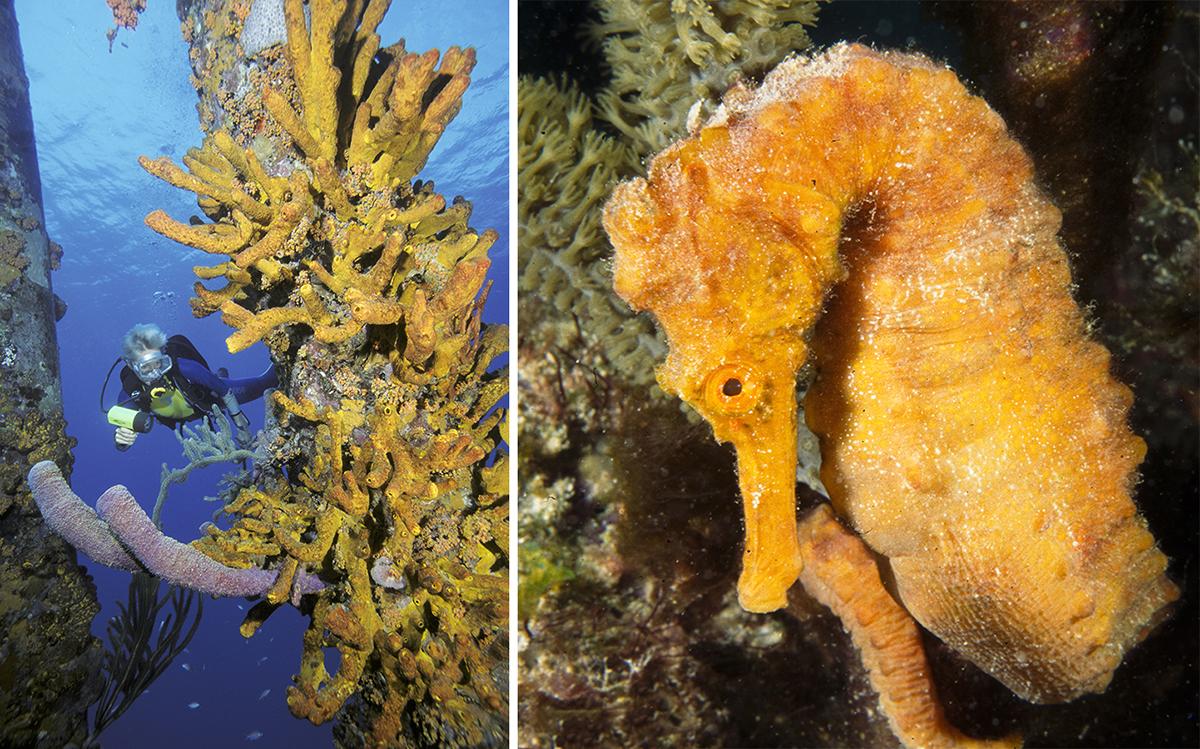
This wonderful hodgepodge of colorful growth from top to bottom provides habitat and shelter for a variety of marine denizens, from squat anemone and Pederson shrimp to longsnout seahorses and longlure frogfish. Further down around the piling’s feet, spotted drums to chain and goldentail morays should be on the watch list as they are abundant here. Adding to these vibrant displays, schools of Creole wrasses, bogas and horse-eye jacks can suddenly appear, turning an otherwise peaceful spot into a melee of activity.
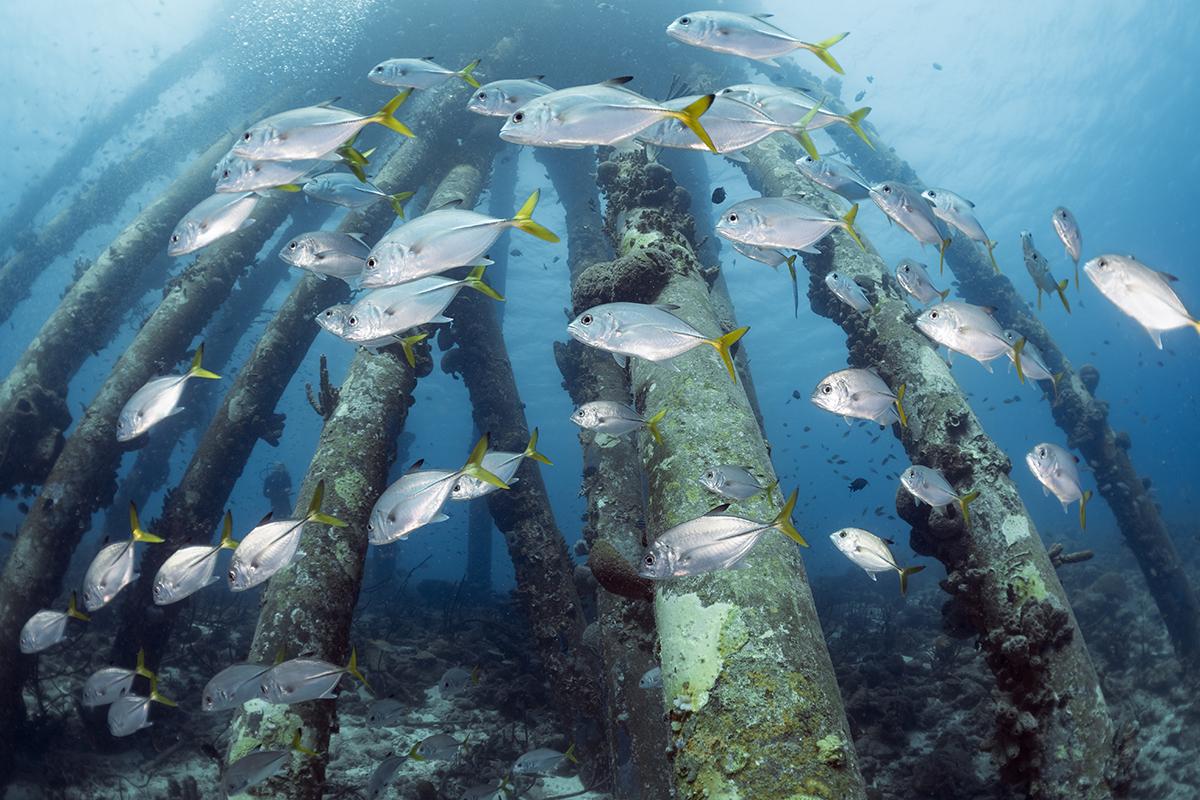
In addition to its scenic draw, the majority of divers that typically come here favor it as a shore dive due to its easy access having a short walk and swim from the parking space on the north side of the pier.
The rewards of diving Bonaire are numerous – typically calm seas with warm clear waters, thriving coral reefs with abundant and diverse marine life. But it is also because no other destination in the Caribbean offers anywhere near as much shore diving as Bonaire.
As I leave you here, should you find yourself in Bonaire, even if it happens to be a repeat visit be sure to take in the Salt Pier.
Photo Credit: Walt Stearns
